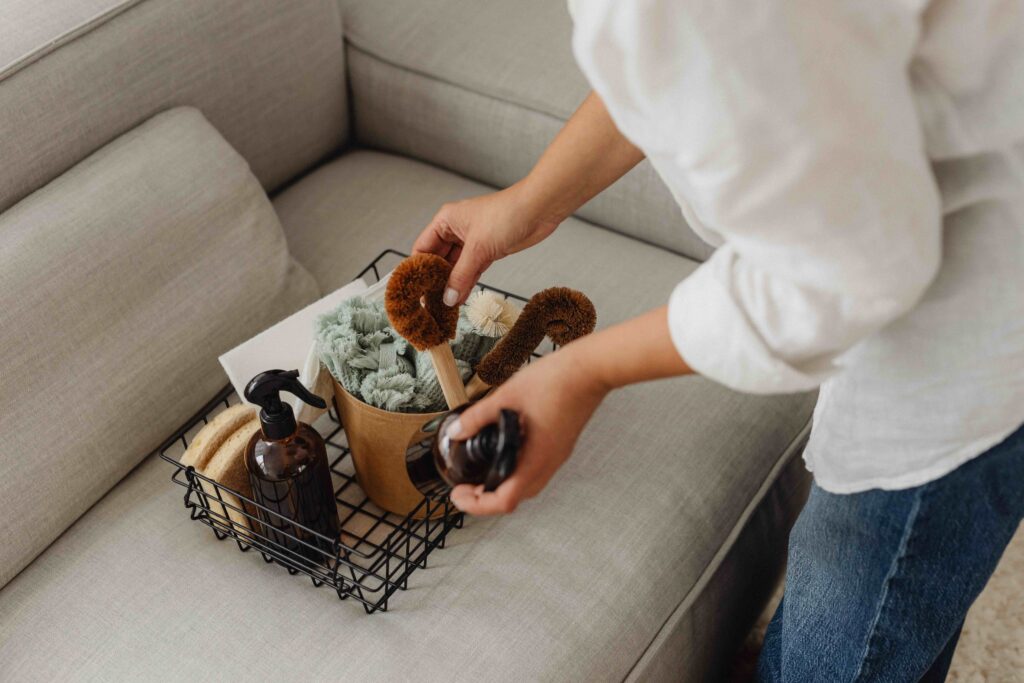Spring Cleaning!
Spring is here (officially in two days)! And in the spirit of new beginnings and renewal, let’s break down how to get rid of the things that don’t matter and keep the things that truly do.
We all have a mess drawer. You know, the one that catches all the mess we procrastinate going through — the one that catches all the ‘junk.’ Having a toddler, especially, things seem to mount up quickly! The list, and different methods below, will help with a reset (a cleaning to lighten up the load of unnecessaries).
This ‘cleaning’ is for everything, whether in your home, office or life in general. What you keep around can have a massive impact on your mental and physical wellbeing, productivity, and overall happiness.
Below is a variety of ways, and detailed guide, on how to get intentional with your things, clear out the clutter and keep only what truly adds value to your space, day and overall life (in this moment).


Spring Cleaning Guide
1. Get Specific on What Matters
Before you start decluttering, it’s important to understand what truly matters to you. Get specific. Grab a notebook and ask yourself questions.
– Does this item serve a purpose in my life?
– Do I use it regularly or need it for my work, health, or wellbeing?
– Does it align with my values or goals?
It also helps to think in categories.
Home: Think about what you need for basic living (clothing, kitchen essentials, hygiene products).
Office: Consider tools that directly help streamline your work (technology, supplies, and reference materials).
Stating the purpose for each item helps you filter out things that don’t support your lifestyle, leaving you with only the things that genuinely support you and your environment.
2. The “One-in, One-out” Rule
The “One-In, One-Out” rule is a great method to maintain balance in your home and office. Whenever you acquire something new, you should think about getting rid of something you already own.
– Before buying something new, evaluate if it truly adds value or serves a purpose.
– When you do purchase an item, remove an old item in exchange. For instance, if you buy a new notebook for work, donate or recycle an old one you no longer need.
The “One-In, One-Out” rule ensures that your spaces don’t accumulate unnecessary items over time, and that every new addition is intentional and has a clear purpose.
3. Declutter by Item Categories
In the “Get Specific on What Matters” suggestion, I stated breaking it down into categories, as far as rooms within your space. Now we’ll break it down into ‘Item Categories.’
Rather than decluttering one room at a time, which can become overwhelming, try tackling item categories. This approach allows you to look at similar items across your whole space, helping you notice patterns or redundancies.
– Clothing: Sort by type — pants, shirts, dresses, jackets, office clothes, loungewear — and assess whether you actually wear or need them.
– Books/Files: Evaluate whether the books or papers are still relevant or useful. Get that shredder ready, to shred the papers you no longer need. Try, also, scanning in the paper documents to make a digital file on your computer.
– Tech and Gadgets: Consider whether old tech, cables, and unused gadgets are serving a purpose or just taking up space.
I opened a drawer this morning, and was met with numerous cables of the same kind. I like to keep an extra set of cables, just in case one gets lost, but I can definitely slim down on the amount!
Focusing on item categories allows you to assess similar items together, helping you spot items that are unneeded.
4. Use the “Four-Box” Method
The Four-Box Method is a popular approach for organizing and deciding what to keep, toss, donate, or sell. This method can be used in both your home and office to streamline the overall process.
– Keep (Box 1): Items you absolutely need or love.
– Donate/Sell (Box 2): Items that may have value to others.
– Trash (Box 3): Items that are broken, worn out, or unusable.
– Storage (Box 4): Items you don’t currently use but still would like to use later (seasonal items and clothes).
The “Four-Box Method” ensures that you give every item a fair chance at being considered, and it allows for a clear decision-making process.
5. Digitize Paperwork and Files
Paper clutter can be a major source of stress in both your home and office. As mentioned in the “Declutter by Item Categories” suggestion, consider digitizing important documents and storing them in a secure cloud storage system or external hard drive.
How to digitize:
– Scan physical paperwork and save it in organized folders on your computer or cloud storage.
– You can use apps like your Google Drive for easier organization and quick retrieval.
– Shred or recycle unnecessary paper documents after digitizing.
Digitizing paperwork reduces physical clutter, makes documents easier to search and access, and minimizes the space they take up in your home and office.
6. Storage
Once you’ve eliminated the unnecessary items, take time to organize the things you decide to keep. Proper organization makes it easier to find what you need, reduces clutter, and helps maintain a tidy space.
Home: Use storage solutions like baskets, bins, and shelving to keep things organized. Group similar items together (cleaning supplies, kitchen tools, personal items) to reduce clutter and make them easily accessible.
In the Office: Use filing systems, labeled folders, and drawer organizers to keep documents, tools, and equipment neat and orderly. Keep only the essentials on your desk — minimize distractions by creating an uncluttered work environment.
Sentimental Items: While it’s important to honor memories, you don’t need to keep every item on hand. Also, consider photographing sentimental items before letting them go, so you preserve the memory without keeping the physical object.
An organized space helps you stay focused, reduces frustration when searching for items, and enhances productivity in your work environment and calmness in your home.
7. Set Regular Decluttering Intervals
Decluttering is not a one-time event — it’s an ongoing process. Set a schedule to regularly go through your belongings and reevaluate whether anything should be removed.
Daily: Spend 5-10 minutes tidying up and putting things away.
Weekly: Take 30 minutes to reassess any new items that have entered your space.
By making decluttering a habit, you prevent your space from becoming overwhelmed by items you don’t need. Regular intervals ensure your environment remains organized and focused.
8. Be Intentional About Your Purchases
Being intentional about what you allow into your space helps you prevent future clutter and ensures everything you own adds value. Ask yourself:
Do I truly need this?
– Consider whether the item will enhance your life, support your work, or bring you joy.
– If in doubt, you can try the “24-48 Hour” rule, when you wait to make a purchase to see if it still feels necessary after the 24-48 hours.
By adopting a minimalist mindset, you avoid unnecessary accumulation and keep your space curated and functional.
Decluttering Checklist!
Need a free, quick checklist to get started (along with our guide)? Download this printable Spring Decluttering Checklist, to be used as a starting point for your spring cleaning!
Last thing!
Currently Listening To:


Okay, now here’s a podcast I’ve been listening to:
The Lazy Genius Podcast, with Kendra Adachi. She’s an expert on compassionate time management. She gives practical advice and states, “she’s here to help you be a genius about the things that matter and lazy about the things that don’t.” Give it a listen while you’re spring cleaning! 🙂
Spring is one of my most favorite times of the year! What fun things are you looking forward in the coming months? Let me know here or on IG!
Happy Spring! 🙂
– Jess


